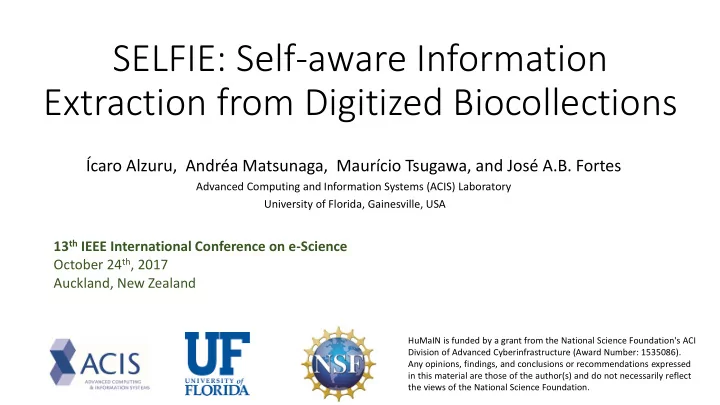

SELFIE: Self-aware Information Extraction from Digitized Biocollections Ícaro Alzuru, Andréa Matsunaga, Maurício Tsugawa, and José A.B. Fortes Advanced Computing and Information Systems (ACIS) Laboratory University of Florida, Gainesville, USA 13 th IEEE International Conference on e-Science October 24 th , 2017 Auckland, New Zealand HuMaIN is funded by a grant from the National Science Foundation's ACI Division of Advanced Cyberinfrastructure (Award Number: 1535086). Any opinions, findings, and conclusions or recommendations expressed in this material are those of the author(s) and do not necessarily reflect the views of the National Science Foundation.
Biological Collections • Extracted metadata can be used to better understand pests, biodiversity, climate change, species invasions, historical natural disasters, diseases, and other environmental issues. • In USA, iDigBio, since 2012, has aggregated 105 M. digitized records. • Worldwide, GBIF accumulates 740 M. records in its database.
Human and Machine Intelligent Software Elements for HuMaIN Cost-Effective Scientific Data Digitization
The problem • Specimens in biocollections have been estimated at 1 Billion in the USA, and almost 3 Billions worldwide. • Automatic Information Extraction (IE) generates errors • Crowdsourcing is relatively slow. • How can biocollections’ IE be accelerated while keeping the quality of the results similar to what capable humans can provide?
Related work – Specimen processing pipeline 1. Pre-digitization Curation 2. Selecting Components for an Imaging Station 3. Imaging Station Setup, Camera/Copy Stand 4. Imaging Station Setup, Light Box 5. Imaging Station Setup, Scanner 6. Imaging 7. Image Processing 8. Organizing and Implementing a Public Participation Imaging Blitz 9. Imaging Archiving 10. Selecting a Database 11. Data Capture 12. Organizing and Implementing a Public Participation Transcription Blitz 13. Georeferencing 14. Proactive Digitization
Related Work • Crowdsourcing platforms: Notes from Nature, Zooniverse. • IE Applications: Symbiota, SALIX Help accelerate but not replace human. • Workflow Management Systems (WMS): Pegasus, Triana, Taverna, Kepler. They could be used to implement SELFIE. • In a previous study, were demonstrated the benefits of hybrid (human- machine) IE solutions. • Self-awareness studies. Applied to other fields, mainly robotics and agents.
SELFIE: Self-aware Information Extraction Workflow Task Self-aware Task (SaT) Self-aware Process (SaP) Self-aware Process (SaP)
Experiment 1 – Event date - Regular expressions utilized to extract dates. - Longer the pattern, higher confident. - Values with identifiable pattern Similarity/Quality Average required time (seconds) per accepted date: SaP/SELFIE # Accepted Similarity SEM Std. Dev. Machine-only 48 0.934 0.024 0.167 Human-only 51 0.971 0.022 0.155 SELFIE 99 0.953 0.016 0.162
Experiment 2: Scientific name SaP/SELFIE # Accepted Similarity SEM Std. Dev. 1. Suffixes 15 1.0 0.00 0.00 2. Dict. Ex. 10 1.0 0.00 0.00 3. Crowd 66 0.944 0.026 0.214 SELFIE 91 0.959 0.019 0.183
Experiment 3: Recorded by SaP/SELFIE # Accepted Similarity SEM Std. Dev. 1. Human 100i 92/100 0.900 0.030 0.288 2. Machine-only 94/300 0.862 0.027 0.262 3. Human 300i 191/206 0.900 SELFIE 375/400 0.895
Conclusions • The paper proposes SELFIE, a hybrid (human-machine) IE model for biocollections. SELFIE is based on the execution of a cost-ordered sequence of IE processes and the use of self-aware tasks which can evaluate the quality of their results and decide whether to accept the values or to send the input to be analyzed to a higher quality process. • Three experiments following the proposed SELFIE model showed that it is possible to extract information from biocollections datasets using less time, human resources, and monetary cost than the human-only IE alternative without significantly degrading quality. • On average, when using the SELFIE model, the time required to extract an accepted value was reduced by 27.14%. This estimated reduction considers only the tasks execution time and the processing time of the data. It does not consider the time needed to organize crowdsourcing activities and developing or setting the required software infrastructure. Likewise, it was not considered the time spent on programming the IE scripts. • On average, the number of required human-hours and other crowdsourcing costs were reduced by 32% when using the SELFIE model, while the quality negligibly decreased by 0.27%. • Three different types of fields, commonly found in biocollections were used in the experiments to demonstrate that self-aware tasks can be created for a wide variety of cases. One case considers field values that are easily identifiable. Another case illustrates a method to create dictionaries from real data in order to enable automatic IE.
Thank you! Any questions? HuMaIN is funded by a grant from the National Science Foundation's ACI Division of Advanced Cyberinfrastructure (Award Number: 1535086). Any opinions, findings, and conclusions or recommendations expressed in this material are those of the author(s) and do not necessarily reflect the views of the National Science Foundation.
Recommend
More recommend